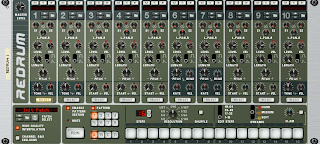Last week we learned a few new things. One: we learned how to create multiple lanes with your Redrum to have each sound on its own lane in the sequencer. Two: we learned how we can use the Dr. REX Loop Player to load in samples and add them to our drum patterns. Three: We gave you a sneak preview in class of how you can use the keyboard to create your own original melodies. For this lesson we will be learning a few things about the Redrum as well as a keyboard technique with the Dr. REX.
With the ReDrum we know that 16 Steps is equal to a Whole Note (aka 1 Bar). This would mean that 16 steps on the ReDrum equals 1/16th Notes. There are 16 1/16th Notes in a Whole Note. This means that we have been making 1 Bar patterns in Reason. Today we'll show you how you can use a feature on the Redrum to create a 2 bar or 4 bar drum pattern. In many cases this may enable you to only have to make 1 drum pattern for a beat without it sounding so monotonous. Let's start with the lesson.
1. Open Reason
2. Create a Mixer 14:2
3. Set your tempo between 80-100bpm.
4. Create a ReDrum
 5. Set your L to 1 and your R to 5. Turn your "Loop On/Off" button to On.
5. Set your L to 1 and your R to 5. Turn your "Loop On/Off" button to On.6. For Sound 1 load in a Clap or Snare. Click it on boxes you normally put a clap or snare on. But WAIT!!! Do you notice the box with the number 16 in red? Change that to either 32 (32 steps = 2 bars) or 64 (64 steps = 4 bars). Next you will notice a switch on the right side of the Redrum that says EDIT STEPS. Move your EDIT STEPS up and continue clicking your Clap or Snare in on the appropriate boxes. You should now have either a 2 bar or 4 bar snare pattern. Copy this pattern to track. Bring your EDIT STEPS back to 1-16 and go to Pattern 2.
7. For Pattern/Sound 2 load in a Bass Drum. Click it on the boxes you would normally put a bass drum on. Click the red 16 up to either 32 or 64. Use the EDIT STEPS function to continue creating your pattern and copy it to track. Bring your EDIT STEPS back to 1-16 and click to pattern 3.
8. For Pattern/Sound 3 load in a Hi-Hat. Click it on whatever boxes you would like. Click the red 16 up to either 32 or 64 and use the EDIT STEPS feature to complete your pattern. Copy it to track.
9. *optional*. Click over to Pattern 4 and load in a Percussion sound (Hi or Other) in Sound 4. Create a 2 or 4 bar pattern and copy it to track.
10. SAVE WHERE YOU'RE AT NOW! Save it as (Your Name) Redrum_Rex.
You should now have 3-4 patterns copied to the track. You should have either a 2 bar or 4 bar pattern. Because your L is 1 and your R is 5 your total loop will be 4 bars. Do NOT begin arranging the pattern in song format as we are just currently working with creating our main loop.
Now this brings us to the Dr. REX Loop Player. When we first started using it last week, we learned that it can be used to play various types of loops. These loops vary from Drums, Percussion and other Instrument loops. The loops that we use are premade and come bundled in with Reason when you purchase it, but it is also possible to make your own Dr .REX loops using another software. It is also possible to take a Dr. REX loop and not have to loop it. This method is often referred to as "Cutting" or "Chopping" samples. Chopping a sample usually refers to cutting a sample up into smaller pieces and rearranging them. This style of sampling was made extremely popular by music producers such as DJ Premier, Pete Rock. These days you'll find this style of sampling used all over: in Hip-Hop, R&B, Pop, Disco and even some Rock. Here are some examples of sample chopping.
So with these examples you see just how possible it is to get creative with a sample. With that said, let's see if we can get creative with some samples!
11. Load in a Dr.REX Loop Player.
14. Create another Dr. REX Loop Player. Load in a Dr. REX Percussion Loop and repeat Step 13.
15. When you are finished with this step save your work. Make sure you put it in your folder on the desktop AND on your folder inside the Yellow DP Audio A Folder.





No comments:
Post a Comment